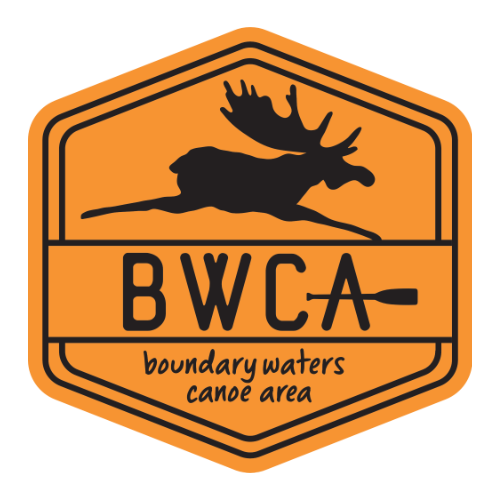BWCA Entry Point, Route, and Trip Report Blog
July 15 2025
Entry Point 16 - Moose/Portage River (North of Echo Trail)
Number of Permits per Day: 5
Elevation: 1348 feet
Latitude: 48.1230
Longitude: -92.0991
Morgan Lake - 45
Bower-Trout to Ram: Cherokee - Vista Loop
Entry Date:
September 13, 2008
Entry Point:
Bower Trout Lake
Exit Point:
Ram Lake (44)
Number of Days:
9
Group Size:
2
Planning, packing, and researching for our trip were now ghosts of the past and we headed north at 5 AM. We are creatures of habit, and we stopped at our usual spots for food and fuel. We motored into Duluth at about noon, ate lunch, and then drove along the “big one”. I never stop marveling at the expanse of Lake Superior and her sparkling waters. At the Tofte Ranger Station we picked up our permit and continued on to Grand Marais.
Around 4 PM we checked into Wedgewood Motel and met the proprietors, Amy and Peter. The Wedgewood is a small motel on the north side of GM. The motel is clean, tidy, no-frills, and inexpensive (on par with a “bunkhouse”). Amy and Peter shared a wealth of information with us. They are fellow paddlers and North House Folk School Instructors (Teaching the art of bread and beer making, respectively). Following, a quick room break, we headed into town for an “Uffda Zah Pizza” at Sven and Ole’s. Along the way, we took note of the turn to the Gunflint, and located the South of the Border Café for our 5 AM breakfast.
Recommendations for our digs at Wedgewood and breakfast at SOB came from my post on BWCA.com. We called our plan the “Bannock plan”. Thanks, Bannock. I also picked up many tips about this country from trip reports and other posts. So, for those of you who write about your adventures, others do read them. Thanks for sharing.
After pizza and a few beers, we headed back to Wedgewood to prepare for the next day. In a moment of stupidity, I convinced Matthew that we should look for ways to lighten our food pack. Never ever again will I remove “too much” trail mix (my mix of M&M’s, salted peanuts, and raisins) from the food pack. Before retiring I listened to Amy’s weather radio. The big question on my mind was the direction of wind for our crossing of Brule on Day 2. [paragraph break] Pictures: 1) Packing and checking the list twice, 2) On Highway 23 south of Marshall, MN, 3) Lake Superior 


It is a little before 5 AM and Matthew and I are standing outside the SOB café waiting for the opening. At 5 sharp the doors open, we walk in, and it didn't take a sociologist to see that the locals call this spot breakfast. “Hi boys, coffee?” our waitress asks. For the regulars, she knows the drill and simply serves it up without a question. Smiles were everywhere, even for us “who ain’t from around here”. What a breakfast we had and it was served in a flash with plenty of SOB coffee. The SOB coffee is made to get you on with the day.
I guess we were on the way to Bower-Trout at 6 AM. It was dark, and the road was fogged in. I had driven to and walked the trail to Bower-Trout back in August under a bright summer sun. Now, in the dark and fog, things looked a whole lot different, and I got confused with the turn onto Forest Service Road 325 off the Gunflint Trail.
On pulling onto a road that looked like a dead end path to a gravel pit, my son asks, “Dad, you sure you know where you are going”? “Yeah, now I do, before, I didn't, the parking lot is just down the hill”. At the parking area, we found one lone vehicle. That was a good sign, now we know how many people are back there. It was now 6:45 AM, and we were glad that we got breakfast in early.
The trail to Bower-Trout follows an old railroad grade. It is a “super highway” of a trail, and we won't be seeing anymore like it. There were plenty of signs that moose were also very fond of this country. Matthew was first down the trail, and nearing the lake, he exclaims “what the hay is that doing here”? And there, occupying the only firm ground at the landing, was an aluminum row boat! Now that was a trick getting that monster in here over a 67r portage. But, why was it left blocking the path?[paragraph break]Picture of the row boat at Bower-Trout[paragraph break]
With that behind us, we launched into the fog at 7:20 AM. Low visibility kept us hugging the north shore till we bumped into the portage on the west side. There are five short portages from Bower to Swan, and each rather pretty. From the look of the trails, the South Brule River also uses these portages on occasion. We could have used a few more inches of water in the river. There was one spot on Dugout Lake that nearly had us lining the canoe. That would not have been pretty considering the bottom had beach-ball-sized boulders, and the shore was lined with thick brush. We only squeaked through after considerable maneuvering and some removal of excess epoxy from the hull.[paragraph break] Under different circumstances, this string of lakes would be a great leisurely paddle. But, on this first day, we were all about getting to Vernon and not about smelling the roses on the way. Swan Lake was a pretty one, and had we been in our right minds, we would have stopped for the day. The paddle west up the meander was a gem. Most of the river bottom is sand, and on a hot summer day, it would be a great wade. There were times when we thought that we had missed the portage. But, magically the portage appeared on left when the river started to disappear into the brush.
The 292 lay ahead of us, and I do not have kind words for this trail. The trail was overgrown and basically cuts through brush the entire way. We were in a hurry, had not taken time to eat lunch, and we were possessed with making Vernon. Matt was as stubborn as I, and neither of us called for a break. He pushed me, and I pushed him. On the Vernon side, we ate our power bars and felt a new found energy. What do they put in those things anyway?
On Vernon, we found the north camp taken, but the SW site was open. It was now 2 PM, and there was no question, we stop here. Rain held off until just after supper, and then the sky opened up. We were not in the mood for putting up a tarp, and it was a natural to crawl into the tent at about 7 PM. In September under a stormy sky daylight is pretty well gone anyway. Our miles came with a lot of work today, and it did feel good to crawl into the sacks. It stormed most all night and a north wind picked up. The increase in wind caused me some anxiety, but as long as it stays from the north, our crossing of Brule should be OK.
Today we saw 1 party camped at Bower-Trout Lake and 1 party camped at Vernon Lake. [paragraph break] Pictures: 1) Morning fog on Bower-Trout, 2) East side of Bower-Trout, 3) Dugout-Skidway burn 


We were up at 6 AM and feeling a good stiff breeze from a NE direction. Both Matthew and I had been apprehensive about Brule Lake. We wanted to get this lake behind us, and today was the day. Are we doing the right thing? We will not know, until we see Brule.
We were on the water at 8:15 for the short, but windy, paddle to the portage. The 55 rods from Vernon to Brule were steep, and our blood was pretty well circulated by the time we assembled our gear on Brule Bay. We shoved off into Brule at exactly 9:15. We could not get a good feel for the wind direction until we entered the main lake near Brule Island. Away from the little bays, we found a brisk and steady NE wind and that would be at our backs. All we needed to do was to hug the north shore.
It is about 8 miles from the NE end of Brule Bay to the west end of Brule. We cleared those miles in 2.5 hours including a snack break along the way. When we hit the larger bays like North and Cone, we paddled north into the bay until the waves looked friendly, and then shot across to the other side. Several times we paused in the lee and watched the south side of Brule. We could actually see white spray thrown into the air as waves crashed against the rocky shore. Brule Lake is a most impressive Lake. The lake is big, and the topography is candy for the eye. The day was not sparkling bright, rather it was misty and rainy, and this added a touch of mystique to our Brule experience.[paragraph break]Pictures show 1) Brule Lake east of Brule Island and 2) Brule Lake near Cone bay 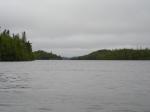

Section 17 camp was not something to write home about, but it was comfortable. The bays and little islands west of us were very picturesque. But with the wind, we did not explore them. Easy firewood was very scarce, but enough was scrounged up for the night. Towards evening the scattered showers went away, and it was supper time, fire time, and Cognac time (in about that order, give or take a few sips). A big full moon rose behind the trees, night became day, and Brule sparkled like a lady in diamonds.[paragraph break]Pictures show 1)Full moon at section 17 camp Brule Lake and 2) the evening fire watch at camp 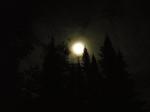

Matt and I were up at 6 AM and looking forward to the day. We had studied the maps, and we figured today would be an easy day in pretty country. The elevation of Brule Lake is 1834 feet and many of the cliffs that lined the lakes ahead were in excess of 2000 feet. We stoked the boilers with sausage gravy and biscuit, washed it down with coffee, and shoved off for the north at 8:45.[paragraph break]Morning at Brule. Picture of lake looking west from section 17 campsite[paragraph break] 



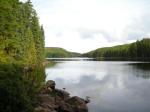


Today we saw no other people.
We were up and about by 6 AM. The day had all the ingredients of a good day as we made the short paddle to the Cherokee portage. With low water this portage presented us with a couple false starts, but we had fun with our creativity.
We first carried to a small pond, and figured here we are. On looking out over the pond, we discovered (falsely) that we can’t get there from here. With some scouting we discovered another trail segment leading to another pond. OK, let’s take a look with just the packs. Oh, crap, this was worse than the first one. So, back we go to pond 1.
We loaded the canoe and headed into the apparent dead end. Surely, there has to be a way through. Ah ha! So, this is where the water goes, when there is water. In the shallows, we stepped out and gentle nudged our canoe forward through a few twists in the channel and one lift-over. At deep water we hopped back in, took a few strokes, and remarked to each other “That was easy enough, and this is probably Cherokee”. The scenery on the north end of Cherokee fell short of what we saw on the "Mechanic Series". We were glad that we took the Cam Lake route.[paragraph break]Pictures show 1) Portage/float into Cherokee Lake from Town Lake and 2) Upper end of Gordon Lake[paragraph break] 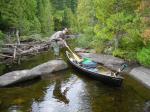

Long Island Lake invited us to explore her little bays. The day was perfect, and we eased the canoe to the north to find another one of those unassuming Boundary Waters camps. On first sighting, the camp on Karl didn’t seem worth the effort to stop. But, it was close to lunch, time for a break, “let’s take a look”. We ate lunch around the fire pit, and slowly the site started to grow on us. From the looks of abundant piles of undisturbed otter scat on the rocks, the site was also a popular spot with the otters. The decision to stop had been made. Today we will look no further, let’s get the tent up.
We had the whole afternoon for dinking around camp, and it was nice not having anything in particular that needed doing. Matthew did some repairs on the sitting logs, I cut a little firewood, and cleared the remains of a fallen tree from the latrine trail. Time always seems to go by so quickly. One minute you have the whole afternoon and the next minute it was time for supper. In the fall, daylight goes quickly after supper.
That evening we had a beautiful fire and an almost full moon. We fed our fire, sipped Cognac, and talked in hushed tones. The light from the moon lit the entire bay behind us. In front, the water was shaded from the light and we listened to the sounds of the forest and water; the splash of a fish and the more ominous crack of a twig somewhere up behind us in the dark of the forest. One sound kept reoccurring. What is that sound out there? Our ears tunes in. I think that is an otter. We could not see him, but we could visualize the actions from the sounds. We think he was gnawing on crayfish, or maybe he was catching fish. Whatever it was, he sounded like he was enjoying the meal splashing about in the dark. We were in no hurry to hit the sack, but finally the wood ran out, and it was time. [paragraph break] Pictures show 1) Karl lake and 2) Karl Lake camp [paragraph break] 

We were up and about at 5:30 AM, and in no real hurry to leave our spot. I had a great night sleep, and the day promised to be a good one. We had a leisurely breakfast as the morning fog slowly lifted. Pancakes and pork patties, washed down with several cups of our special cowboy coffee, should power up our engines for the Muskeg-Kiskadinna portage.[paragraph break] Picture shows Entering Long Island Lake from Karl 



We were expecting the worst on the portage into Kiskadinna. The whole portage is not that bad. There is a gain of 147 feet between Muskeg and Kiskadinna. A portion of the trail seems straight up and it did spark a fire in my legs and had me puffing as I approached the top. After that, it was basically an easy stroll to Kiskadinna. In comparison to the string of portages that we did on the “mechanic chain” of Day 3, I think that the “notorious wall” was, in fact, an easier go. But, we also hit this portage well rested and well fueled.[paragraph break]Pictures show the steep part of the Muskeg-Kiskadinna portage (some call it the wall)[paragraph break] 



Of the trip, this day was my favorite. The weather behaved. I enjoyed the diversity of the country we passed though including the portages. We saw one canoe on Long Island Lake and Omega Lake, and spotted only one other camper.
We were up at about 6AM. I had a restless night. The wind picked up as we were bedding down and it continued to howl most of the night. The tent pad at this site was up hill from the lake, and it seemed every gust was amplified in the branches of the poplars. Between the wind and the location, our tent was perfectly dry this morning. It is so much easier to pick up dry gear.
Breakfast was biscuit and gravy. I think that is one of our best meals. We make the biscuit the night before, so in the AM we only need to make our sausage gravy and coffee. This meal sticks to the ribs too. In the distance a small rumble was heard. Thunder?
The paddle down Pillsbery was idyllic and the 95 r into Allen was a nice easy portage. On the trail we spotted a very nice and very fresh bear track. The bear had been using part of the trail and we had just missed an encounter of the bear kind.[paragraph break]Picture shows a fresh track of company on the trails[paragraph break] 
The rain held off till we hit the 21 r portage into Vista. We suited up and waited out the heaviest of the rain to pass. Wind was directly out of the south and that made our launch off the boulder field into Vista a bit tricky. The camp on section 29 of Vista was a terrible place requiring several mountain goats to get up to it. Once on top, both Matt and I came to the same conclusion; let’s get out of here rain or no rain. There was a nice looking camp on the south end, but it was taken. There was no sense in going back to pick-up one of the sites that we had passed, so it was on to Misquah.
The portage into Misquah Lake is only 50 r. Most of it is uphill, and most off it was slippery following the rain and the new layer of fallen leaves. On the lake side, we put in at the first water we saw without realizing that the proper entry was a few rods further. No matter, we loaded, the canoe floated, and we made our way into deep water. We almost paddled right by the camp on the south end. It was somewhat hidden back from the lake. “Whoa, was that the camp site we just passed’? It was vacant, and it was time to stop.
The Misquah camp is another one of those spots that tended to get better as we made ourselves at home. It was definitely protected from the winds, but there was no boulder-free flat spot for tents. We creatively pitched our tent over a rock. Actually it worked out pretty good. There was a great campfire ring, and the fire wood was plentiful. We had a good fire that evening
Across the lake from our site was an old burn, and from that country we had been hearing the distinctive call of a moose in love. This lover’s concerto kept us amused, as long as he stayed over there, and didn’t come looking for love on our side of Misquah. Today we only saw the one group of campers on Vista Lake. [paragraph break] Pictures: 1) Ahead of the storm on Allen Lake and 2) Misquah Camp 

We rolled out of the tents at our usual hour and went through camp chores for a final time. These are bitter sweet moments. We know the trip is done. On one hand we are ready to come out, but on the other we did not want to let it go. Our last breakfast was a Mexican omelet and mucho coffee. Camp was picked up, and we left our campfire ring with a neat little pile of kindling. It was picture perfect, and we only hope that the next visitors will find this spot as special as we found it.[paragraph break]Pictures show our last breakfast on the trail and a departing shot of the camp[paragraph break]
 [paragraph break] The portage into Rum was a good kick start to the day. Up, abruptly and down just as fast. Great view from up here, huh? The Rum to Kroft trail was mostly flat, and the hand of fall hand had painted the leaves beautiful shades of orange and gold just for us. At Ram we paused at the portage for a father-son picture, a bit of meditation, a sip of cognac, and a smoke. The last lake. The portage out of Ram Lake is a little bit up and mostly all down. There was one car in the parking lot (Entry #44) and it likely belonged to the campers that we passed on the west end of Ram.[paragraph break]Pictures show Rum-Kroft portage and climbing out of Ram[paragraph break]
[paragraph break] The portage into Rum was a good kick start to the day. Up, abruptly and down just as fast. Great view from up here, huh? The Rum to Kroft trail was mostly flat, and the hand of fall hand had painted the leaves beautiful shades of orange and gold just for us. At Ram we paused at the portage for a father-son picture, a bit of meditation, a sip of cognac, and a smoke. The last lake. The portage out of Ram Lake is a little bit up and mostly all down. There was one car in the parking lot (Entry #44) and it likely belonged to the campers that we passed on the west end of Ram.[paragraph break]Pictures show Rum-Kroft portage and climbing out of Ram[paragraph break]
 [paragraph break] We only have one more thing to do and that is to retrieve our truck form the entry at Bower-Trout (#43). With that, we turn our backs on our equipment and head off for the mile walk to entry 43. Hunting season has started, and several pickups passed us as we walked along. They were hell bent on finding their game. I know we didn’t present a picture of someone that you would offer a ride to. But, at least you guys could have slowed down as you passed. I know we needed a bath, but I did not appreciate the dust bath. Thank you.
[paragraph break] We only have one more thing to do and that is to retrieve our truck form the entry at Bower-Trout (#43). With that, we turn our backs on our equipment and head off for the mile walk to entry 43. Hunting season has started, and several pickups passed us as we walked along. They were hell bent on finding their game. I know we didn’t present a picture of someone that you would offer a ride to. But, at least you guys could have slowed down as you passed. I know we needed a bath, but I did not appreciate the dust bath. Thank you.
Finally, there is the truck and the tires are on it. Good sign. The glass is intact. No trees have fallen on it and I hear the reassuring click as the locks open. We climb inside. Damn these seats feel real comfy don’t they? Now, back up the road to collect our gear, pack, and salute again with a Heineken, salami and cheese.
We had told Amy and Peter at Wedgewood Motel that we might drop by after the trip. We did not want to get locked into reservations, so it was a crap shoot if there was room at the Inn. At highway 61 we headed north out of GM to Wedgewood. Maybe we will be lucky. The No Vacancy light was on, but we pulled in. Again, Amy was delighted to see us. She explained about not having time to clean up the rooms (except for reserved guests) and thus, the No Vacancy sign. She had one room clean, smiled, gave us the key, and we talked up the trip.
After showers, we headed into GM to find a steak and beer. In the morning we stopped into SOB cafe and fueled up our bodies for the drive back to South Dakota. I think it was easier leaving GM this day than is was leaving Little Trout yesterday. [paragraph break] Pictures show 1) Ram Lake, 2) Matt (PitchStump) and Joe (HighPlainsDrifter) getting ready to paddle our last lake (Ram), 3) The last portage and all down hill to the entry 


Everything after Day 1 and 2 seemed "not so bad" including the notorious "wall" from Muskeg to Kiskadinna and the Misquah - Little Trout portage. However, we also hit each of the difficult portages on short days, well fed, and rested. The state of your mind has a lot to do with how you remember a difficult section of trail. We stayed away from Winchell and followed Omega-Henson-Allen-Horseshoe to get back to Ram. I loved the small chain of lakes and I have no regrets about the path we selected.
The big negative about this loop was the constant encounters with "new entry points" as you loop around. Basically you never move away from being in close proximity to entry points (with the obvious exception of the start and finish). Actually we did not see many people at all. But from the looks of the camps, the country around Brule Lake and Poplar Lake gets hit hard. We also tripped late season and that has a lot to do with encountering other travelers. The big plus for this loop was the diversity of the country, beautiful hills, very pretty lakes, maintained portages, and solitude. My favorite day was Karl to Omega. My favorite camps were on Karl and Little-Trout.
